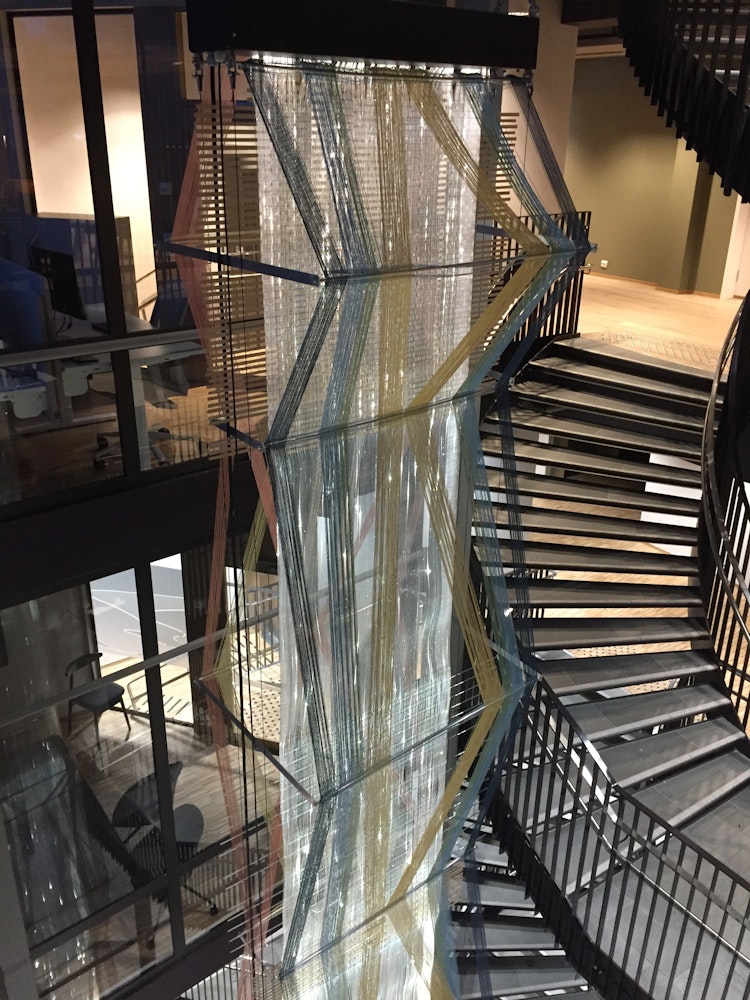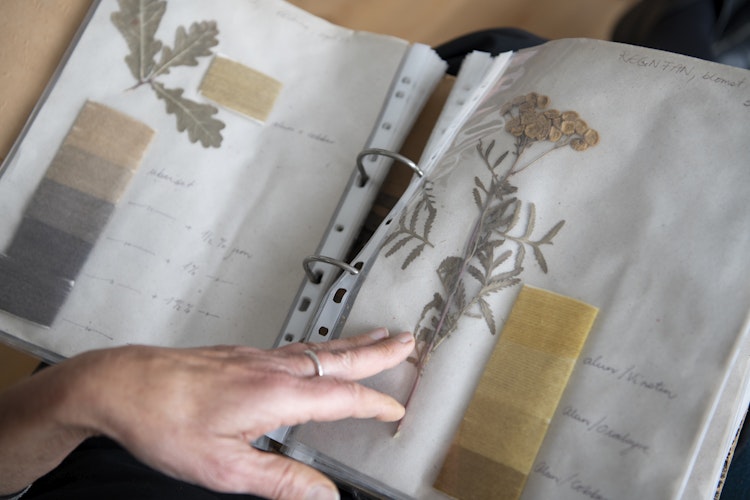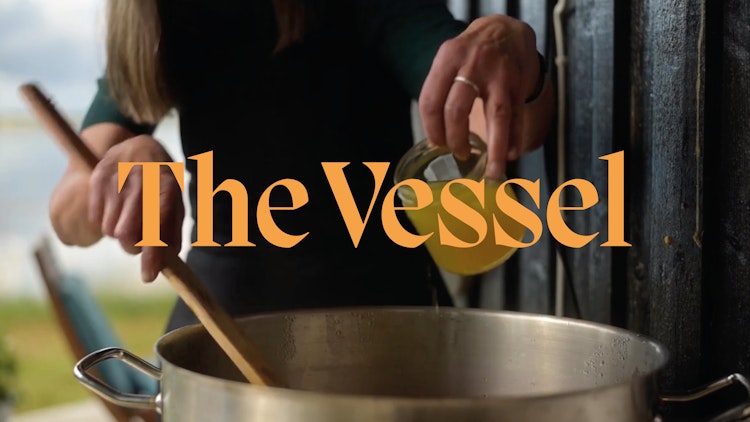In this film and interview by Hilde Sørstrøm and Ingun Mæhlum, artist Hilde Hauan Johnsen shares the background to her interest in plant dyeing and ancient weaving techniques, and for plant life around the world. Through her method of foraging plants and creating dyes, Hilde Hauan Johnsen’s artworks become archives of specific landscapes.
Bright yellow and pink fabrics attached to strings are floating in the wind, while other colourful fabrics are dipped into a casserole placed on the bonfire outside Hilde Hauan Johnsen’s cabin. Johnsen is a textile artist educated in Canada, Denmark, and Norway. After studying and working abroad for 10 years, Hilde Hauan Johnsen moved back to Tromsø, where she had her studio and worked as an artist and as a scenographer for theatre and television while raising her 3 kids.
In 2004 she became professor and head of the textile department at The Academy of Fine Art in Bergen. For close to 14 years, she commuted the 1200 kilometres between her studio and family life in Tromsø and her professorship in Bergen, before eventually leaving the position. Her artistic practice is her main occupation now, while maintaining part-time professorial positions at the Academy of Fine Art at UiT The Arctic University of Norway, located in Tromsø, and at Sámi Allaskuvla in Guovdageaidnu.
Hilde Hauan Johnsen is known for her art installations using fibre optics, a form of technology where light pulses is sent through thin, transparent fibres of plastic with a glass core. However, for the past 15 years plant dyeing has become an increasingly important part of her practice. Hauan Johnsen spends a lot of time at her cabin, located a short drive just outside the city of Tromsø, in Northern Norway. The cabin acts as a second home, her outdoor studio, and a social space where Hauan Johnsen can invite students and other artists to take part in art projects or workshops, often related to plant dyeing. She tells me she is currently working on 15 old damask tablecloths that she will dye using different plants and then bring to Denmark, where she is part of the ongoing group exhibition Soil.Sickness.Society at Kunsthal Rønnebæksholm.
Plant dyeing, weaving, spinning, and other craft skills — this was all part of my childhood. I learned all these textile skills from my mother, my grandmothers, and my aunts.

“The space [Kunsthal Rønnebæksholm] is a huge old farm with a really nice garden,” says Hauan Johnsen. “We are a group of artists working in a part of the exhibition called The Medical Garden for Radical Caring. We work with herbs, plants, and the soil in a 340 square metre flower bed. For my part, I’m working with plant dyeing. I use plants from the garden, the surrounding environment and bring some from the North. I give workshops, so that the public can learn how to use these plants.”
“In this exhibition, I’m also a part of the ‘pigment garden’, run by Sara Gade. The flower bed is divided into three parts, with different plants that give red, blue, and yellow colours when dyed. From there, we can mix colour and make green and orange and purple and so on. It’s always a joy to plant dye and to see the colours come out. You are never disappointed. It always gives you something.”


A living part of the family structure
Ever since Hilde Hauan Johnsen was a child, traditional skills have been an important inspiration for her, both in her art and in her life in general.
“Plant dyeing, weaving, spinning, and other craft skills — this was all part of my childhood. I learned all these textile skills from my mother, my grandmothers, and my aunts. I am part of the generation that still had this as a living part of the family structure.”
But it was not only practical skills that she learned. The art of working together and collaborating – which would later become so important in her artistic practice – was also part of her upbringing.
“When it was time to weave floor mats, all the women in the family would gather to cut the cloth for the floor mat.1 And we, the children, took part in it. It was the same with plant dyeing. My aunt really loved to plant dye, and I often joined her.”
One of Hauan Johnsen’s most important art projects is the collaborative The Stitch Project, which combines embroidery, plant dyeing, and spinning. In this ongoing project, she works together with five other artists: Kiyoshi Yamamoto, Maria Skeie, Margrete Kolstad Brekke, Britta Marakatt Labba, and Omaya Salman. They travel within Norway and internationally with a 10-metre linen cloth, which they invite people to embroider on while talking together. Since the start of the project in 2012, they have visited more than ten different countries and more than 40 events, from biennials, to festivals, exhibitions, and galleries.
"Stitching is a universal act and an important part of culture all over the world. Everyone uses the stitch in one or another way,” Johnsen says.
Using the needle, the thread, and the tablecloth to bring people together is the most important part of the art project. But plant dyeing is also a central part of it.
“When we visit the different places, we look for plants and trees. What do we see the most of? What kind of leaves can we pick? Then we spin, embroider, and dye wool yarns or cloth with these different plants and make a portrait, in colour, of this place.”
Exploring borders
In 2021, Nordnorsk Kunstmuseum bought Hilde Hauan Johnsen’s plant dyed textile installation titled Fargeprisme fra NATUR 1: Norge/Russland & Palestina/Israel (2019) (Colour Prism of Nature 1 – Norway/Russia & Palestine/Israel). It is part of a series she is still working on. This particular installation consists of approximately 30 silk fabrics, hanging alongside each other creating a tall 6 by 4 metre curtain of different colours. In total, 120 metres of silk is used in this massive installation. It speaks about materiality, process, and knowledge passed through generations. The colours are from different plants gathered in Palestine and Israel, as well as by the border between Russia and Northern Norway. By harvesting, archiving, and using plants from these borders, Hauan Johnsen is investigating what the landscape can transfer to us in terms of knowledge.
“What I am curious about in this topic of borders is actually: if I go back in two or five years, will I find the same borders? Will the same plants be there? How are these borders (and the plant life) impacted by the political situation, or by climate change? I don’t think that everyone who sees this artwork will be curious about the same things as me. But for me, it is important that I will be able to go back later, and maybe find changes, and to bring back my experience from these places.”
A change in attitude
In recent years, we have seen a change in attitude towards traditional crafts. Working as a professor of textiles in Bergen between 2004 and 2018 (and now in Tromsø), Hauan Johnsen has experienced this renewed interest in textiles among her art students.
“When I came to the academy in Bergen in 2004, we could, within a few years, see a growing interest for the traditional crafts in textile. The students wanted to learn how to spin and how to weave, and they wanted to use these skills in their artistic practice. I experienced the same in Tromsø. When you have 18 out of 40 students wanting to be part of a workshop in embroidery with Britta Marakatt-Labba, or in large-scale fabric dyeing with Kiyoshi Yamamoto and me, or in weaving, that’s quite amazing in a small academy.”
Perhaps the most important shift in the textile arts that Hilde Hauan Johnsen has been a part of is the merging of the analogue with the digital. Through technological advances, the textile art field has incorporated new tools to explore and develop aesthetic qualities and expressions. Weaving, for example, has had a huge comeback in combination with digital technology.
“In Bergen, we got the first digital jacquard loom at the school’s weaving studio when I started as a professor in 2004. A lot of students became interested in this digital loom, where you sit and weave as if it is an old traditional loom, but you use the computer to feed the loom with the image or pattern you have prepared on a computer. It takes time to learn, and it’s interesting to see how engaged young artists are.”
Fibre optics
Since 2000, Hilde Hauan Johnsen has experimented with fibre optics in many of her artworks, often in combination with old techniques. One of her latest pieces, the installation from hearth of the house (Fra Arnestedet,) which she made for Sparebanken Nord-Norge’s bank quarter in Tromsø, together with her son who programmed the light sources, is a great example of how a technological material may inform her artwork. In this particular piece, she also combined fibre optics with plant dyed materials for the first time in her practice.
She explains that the reason she chose to combine fibre optics with weaving and dyed yarns is that she wanted to bring together something old and something new, something high tech with something low tech.
“I dyed linen yarns with plants gathered around Tromsø. These were plants that I know have a history of being used in folk medicine, which is something I often use. I wanted to mix this old tradition with new technology that you would find in a bank. This building is packed with new technology. For example, there are fibre optics in broadband. And I use the same technology in my artwork. Except I do not send emails or things like that through it, I send light. When I made the artwork, I used fibre optics for the warp, and for the weft I used steel tread, glass bars, thin birch veneer. The outer layer was woven with the linen thread which was plant dyed, using plants that is also part of the folk medicine tradition in the north”




A thread from the past, to the present and future
This summer, Hilde Hauan Johnsen has been to Porsanger and Stabbursdalen in Finnmark to collect plants that she cannot find in Tromsø. She is particularly looking for plants that give off red colours. These plants have been used a lot in the north, and probably many other places, she tells me. For example, it’s been used to dye the thin wool fabric used in the Sámi gákti.2
But how does she know what she is looking for and where to find these plants?
“We have a long tradition for using different lichen such as steinlav [Montanelia disjuncta], also known in Norwegian as fargelav ("lichen for dyeing") and messinglav (“brass lichen”). The elders who taught me how to use the lichen had their special sites where they would harvest these. They knew what conditions were needed in the habitat for them to give off good colours. A lot of knowledge is now lost, but luckily, we have managed to keep many of these traditions alive.”
Historical knowledge passed through preservation and developing traditional skills is highly inspiring for Hauan Johnsen as an artist. It is also prevalent in her artworks mentioned here, and in several others. Hauan Johnsen’s practice reveals a certain level of care, not only for old traditions, but also for the environment. As Hauan Johnsen underlines: plants are a renewable source as long as you don’t take the roots when collecting them. At the end of our talk, she says something that perfectly connects her artistic practice to both the past, the present, and the future.
“In the boat of Oseberg, one of the richest Viking graves that we have discovered in Norway, a queen is buried together with a couple of her maids. In her grave you also find many hundred textile fragments and equipment to do different kinds of weaving. There are cloths that is dyed in different ways, and it is so finely woven. All these different plants that they used for dyeing, we still use today. Woad [Isatis tinctoria], for example, which is used for its blue colour, has been growing in Norway since that time, and maybe long before that. I grow it in my garden now.”
The artist has no doubt that traditional skills will follow us further into the future.
“If plant dyeing has gone on from before the year 830, when this queen was buried, until today, it will continue at least the same number of years ahead of us. I’m sure of it. And it’s the same when it comes to weaving. When I’m sitting by my loom, weaving, I know the act I’m doing is something that has been going on for thousands of years already. So why should it stop with me? I cannot see that happening.
